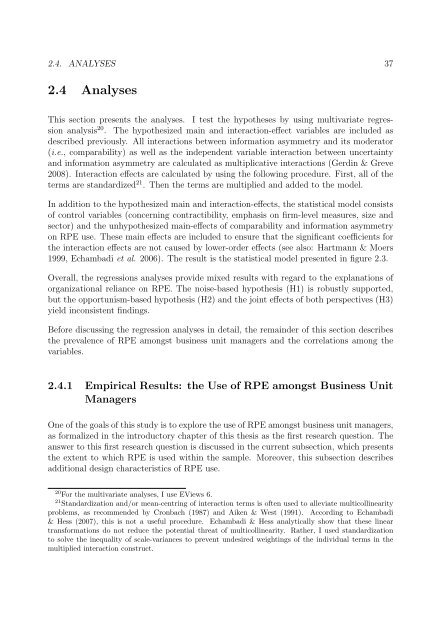pdf - Nyenrode Business Universiteit
pdf - Nyenrode Business Universiteit
pdf - Nyenrode Business Universiteit
You also want an ePaper? Increase the reach of your titles
YUMPU automatically turns print PDFs into web optimized ePapers that Google loves.
2.4. ANALYSES 37<br />
2.4 Analyses<br />
This section presents the analyses. I test the hypotheses by using multivariate regression<br />
analysis 20 . The hypothesized main and interaction-effect variables are included as<br />
described previously. All interactions between information asymmetry and its moderator<br />
(i.e., comparability) as well as the independent variable interaction between uncertainty<br />
and information asymmetry are calculated as multiplicative interactions (Gerdin & Greve<br />
2008). Interaction effects are calculated by using the following procedure. First, all of the<br />
terms are standardized 21 . Then the terms are multiplied and added to the model.<br />
In addition to the hypothesized main and interaction-effects, the statistical model consists<br />
of control variables (concerning contractibility, emphasis on firm-level measures, size and<br />
sector) and the unhypothesized main-effects of comparability and information asymmetry<br />
on RPE use. These main effects are included to ensure that the significant coefficients for<br />
the interaction effects are not caused by lower-order effects (see also: Hartmann & Moers<br />
1999, Echambadi et al. 2006). The result is the statistical model presented in figure 2.3.<br />
Overall, the regressions analyses provide mixed results with regard to the explanations of<br />
organizational reliance on RPE. The noise-based hypothesis (H1) is robustly supported,<br />
but the opportunism-based hypothesis (H2) and the joint effects of both perspectives (H3)<br />
yield inconsistent findings.<br />
Before discussing the regression analyses in detail, the remainder of this section describes<br />
the prevalence of RPE amongst business unit managers and the correlations among the<br />
variables.<br />
2.4.1 Empirical Results: the Use of RPE amongst <strong>Business</strong> Unit<br />
Managers<br />
One of the goals of this study is to explore the use of RPE amongst business unit managers,<br />
as formalized in the introductory chapter of this thesis as the first research question. The<br />
answer to this first research question is discussed in the current subsection, which presents<br />
the extent to which RPE is used within the sample. Moreover, this subsection describes<br />
additional design characteristics of RPE use.<br />
20 For the multivariate analyses, I use EViews 6.<br />
21 Standardization and/or mean-centring of interaction terms is often used to alleviate multicollinearity<br />
problems, as recommended by Cronbach (1987) and Aiken & West (1991). According to Echambadi<br />
& Hess (2007), this is not a useful procedure. Echambadi & Hess analytically show that these linear<br />
transformations do not reduce the potential threat of multicollinearity. Rather, I used standardization<br />
to solve the inequality of scale-variances to prevent undesired weightings of the individual terms in the<br />
multiplied interaction construct.
















